
Orthocenter: Are the perpendicular bisectors of the sides of triangles really concurrent?
Brian Swanagan
We begin first by constructing a triangle ABC and its midpoints D, E, and F.

Now, we will construct a perpendicular bisector to side BC through point D.
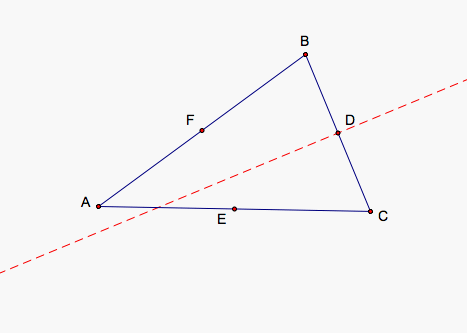
The perpendicular bisector line is equidistant from B and C at any point along it. Below, I demonstrate the truth of the statement by selecting points along the line and drawing segments from B and C to those points including D.
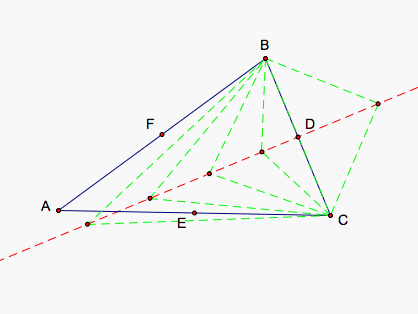
It certainly looks true that any point along the red line is equidistant from B and D. We can easily verify the statement's truth by drawing the green segments from B and C to the point. Now, we have two triangles (other than when our point on the line is D and we already know that D is the midpoint of the segment BC so it is equidistant). The two triangles are formed by the red line, one of the green lines, and half the blue side BC. The length of BD = DC and the angle at D for each is a right angle because the red line is the perpendicular bisector to the side. Both triangles share the red segment from D to the point as well. We then use the Side-Angle-Side theorem to say that the two triangles are congruent so the green segments must also be equal in length. Then the point is equidistant from B and C.
Now, we have shown that every point along the perpendicular bisector of BC is equidistant to B and C. We would like to show that any point P that is equidistant from B and C would also be on the line. Draw segments BP, CP, and DP. We now have two triangles BPD and CPD. From our assumption, BP and CP are equal. D is the midpoint for BC so BD and DC are also equal. Both triangles share side DP giving us our third equal side. The triangles then are congruent and DP and DC are equal to DP and BD respectively so the angles BDP and CDP are equal. The two angles added together are 180 degrees because they are along segment BC. 180 divided into two equal parts gives 90 degrees for each part. So, DP is perpendicular to BD and includes the midpoint D which means P lies on the perpendicular bisector to BC. This means that every point equidistant from BC lies on the perpendicular bisector.
Now, we have that every point that is equidistant from BC if and only if it lies on the perpendicular bisector to BC.
Next, I will draw a perpendicular bisector to AC. I also added some points on the line with segments from A and C to the points to demonstrate that any point on the line is equidistant to A and C.
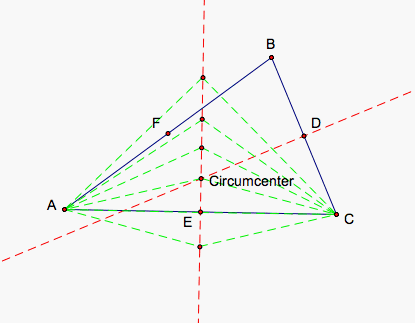
The point of intersection which we will call the circumcenter is equidistant then from B and C as well as equidistant from C and A so it is also equidistant from A and B. If the point is equidistant from A and B, then it should lie on the perpendicular bisector to AB.
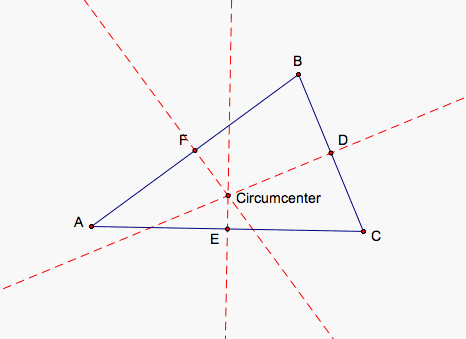
The point does lie on the new line as we expected so all 3 lines are concurrent. I will add some points to the line and connect them to A and to B again to show that they do in fact appear to be equidistant.
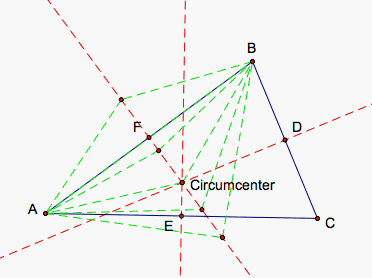
If the point is really equidistant from all 3 points, then we should be able to draw a circle with its center at the intersection that passes through all 3 points.
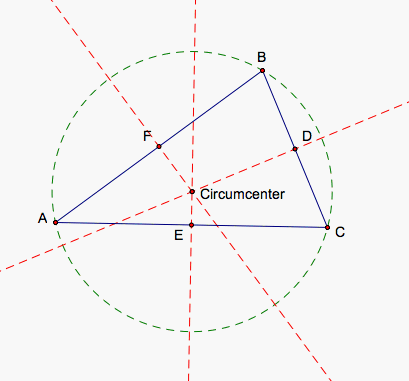
We see that we can draw a circle through A, B, and C with its center at the intersection of the perpendicular bisectors so we can verify that the point is equidistant from all 3 vertices of our triangle.
So, if you can find a circle that passes through 3 points on a triangle and locate its center, then you have a point thats equidistant from any 2 points which means it lies on the perpendicular bisector for the segment between the two points. Because this is true for any two points, then this point lies on all the perpendicular bisectors giving you the intersection of all three lines.